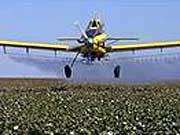Law prohibits human exposure
February 17, 2003
Minnesota state law specifically prohibits human exposure to pesticides during application.
Moorhead, Minn. —
18B.07 Pesticide use, application, and equipment cleaning.
Subdivision 1. Pesticide use.
Pesticides must be applied in accordance with the product label or labeling and in a manner that will not cause unreasonable adverse effects on the environment within limits prescribed by this chapter and FIFRA.
Subd. 2. Prohibited pesticide use.
(a) A person may not use, store, handle, distribute, or dispose of a pesticide, rinsate, pesticide container, or pesticide application equipment in a manner:
(1) that is inconsistent with a label or labeling as defined by FIFRA;
(2) that endangers humans, damages agricultural products, food, livestock, fish, or wildlife; or
(3) that will cause unreasonable adverse effects on the environment.
(b) A person may not direct a pesticide onto property beyond the boundaries of the target site. A person may not apply a pesticide resulting in damage to adjacent property.
(c) A person may not directly apply a pesticide on a human by overspray or target site spray, except when:
(1) the pesticide is intended for use on a human;
(2) the pesticide application is for mosquito control operations conducted before June 30, 2003, in compliance with paragraph (d), clauses (1) and (2);
(3) the pesticide application is for control of gypsy moth, forest tent caterpillar, or other pest species, as determined by the commissioner, and the pesticide used is a biological agent; or
(4) the pesticide application is for a public health risk, as determined by the commissioner of health, and the commissioner of health, in consultation with the commissioner of agriculture, determines that the application is warranted based on the commissioner's balancing of the public health risk with the risk that the pesticide application poses to the health of the general population, with special attention to the health of children.
(d) For pesticide applications under paragraph (c), clauses (3) and (4), the following conditions apply:
(1) no practicable and effective alternative method of control exists;
(2) the pesticide is among the least toxic available for control of the target pest; and
(3) notification of residents in the area to be treated is provided by direct notification and through publication in a newspaper of general circulation within the affected area.
(e) For purposes of this subdivision, "direct notification" may include mailings, public meetings, posted placards, neighborhood newsletters, or other means of contact designed to reach as many residents as possible.
(f) A person may not apply a pesticide in a manner so as to expose a worker in an immediately adjacent, open field.
Subd. 3. Posting.
Sites being treated with pesticides through irrigation systems must be posted throughout the period of pesticide treatment. The posting must be done in accordance with labeling and rules adopted under this chapter.
|
News Headlines
|
Related Subjects
|

